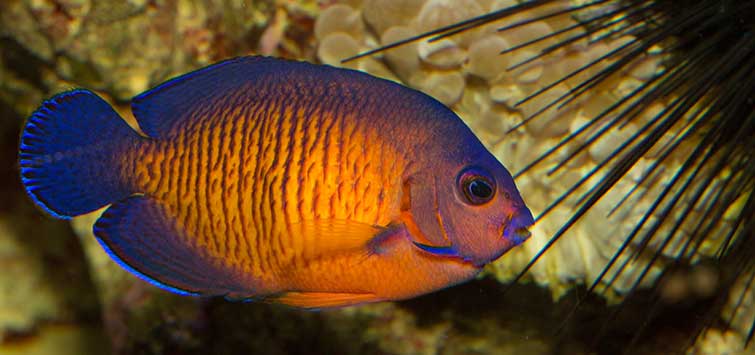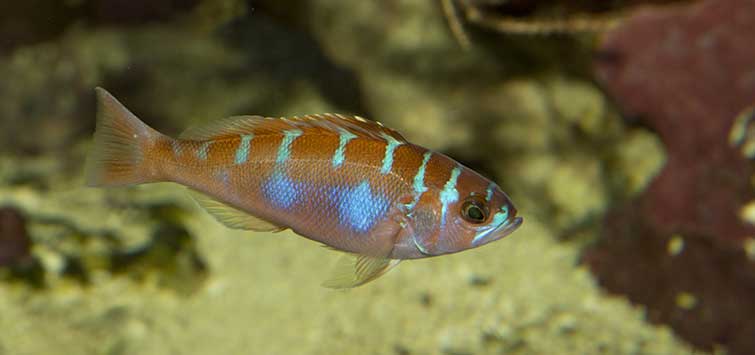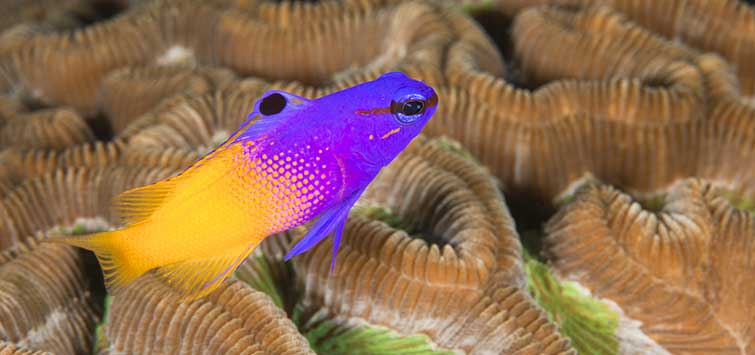Splendid Species for Novice Marine Fishkeepers
Author: Richard Aspinall
Entering the world of marine fishkeeping is both fascinating and rewarding, but it might also on occasion exasperate and disappoint. Novices to the saltwater hobby, even with some freshwater fishkeeping experience under their belts, are in for a remarkable ride of ups and downs as they travel from self-doubting beginners to confident marine hobbyists who are capable, knowledgeable, and able to provide the best conditions for their tank’s inhabitants.
Before You Begin
Keeping marine fish—as with corals, clams, and other invertebrates— shouldn’t be something that you decide to do on a whim. Novices should understand that maintaining a successful marine aquarium requires a commitment of time and money, as well as patience and the willingness to conduct research. The latter two may be the most important. If you rush into things, or don’t read up on the fish and animals you intend to keep, you may end up wasting a lot of money, killing many amazing creatures and giving up on what could be a life-changing hobby out of frustration.
Getting a tank properly set up for its first fish is a complex subject I won’t attempt to cover here, so I’m going to assume that your tank has already cycled and all the equipment is in place, and now you are ready to start selecting fish. If you’re not sure if your tank is ready, then first conduct additional research and water tests. Do not rush it! A few extra weeks of preparation is worth it for a hobby that may last a lifetime.
Great Marine Fish for Beginners
When you are ready to begin stocking, the following are some suggestions for a novice marine/reef fishkeeper interested in starting off right.
Royal Gramma (Gramma loreto)
The royal gramma (Gramma loreto) is a wonderful fish from the tropical western Atlantic. It stays small at around 3 inches (7.5 cm), is fantastically colored with a half-purple and half-yellow coloration, and is easy to feed. It will accept frozen foods and some dried foods, and will refrain from nipping at corals and most sessile invertebrates. It might eat small shrimps, however, as this carnivore takes small crustaceans as its main source of nutrition in the wild.
Above all, G. loreto is one of the most peaceful of its kind, though it may squabble with other fish that look similar to it. Offer it a tank of 30 gallons or more with a lot of open rockwork for exploration and it will reward you for years to come. Don’t try to keep two of them together, though, as they would likely fight until only one remains.
Percula Clownfish (Amphiprion percula)
It’s hard to picture a marine aquarium without thinking of clownfish. Their astonishing coloration, charming demeanor, and symbiotic relationships with anemones make them endlessly fascinating, and they are some of the most easily cared for and readily available marine aquarium fish. Even better, they now come in many stunning varieties.
The most common clownfish in the hobby is Amphiprion percula. Its wild form is a beauty, with strong black lines between its orange and white patches, but its ease of breeding has led commercial operations to create other interesting color and pattern variations in percula clownfish and its close relatives. Some aquarists disapprove of these morphs, while others are avid collectors of each variety to hit the stores.
For the beginner, this means there are many inexpensive specimens available for the aquarium that also do not place stress on wild populations. That makes this fish a win for everyone in the hobby.
Clownfish can be kept singly or in small groups, but if you want to reap the full enjoyment of their behavior, try to source two fish that have already paired up. You don’t have to keep them with an anemone, as they will survive without one, but procuring one of the easiest-to-care-for anemone species, such as the bubble-tip (Entacmaea quadricolor), will allow you to observe the natural behavior of your clownfish. Bubble-tip specimens are often available from other hobbyists whose anemones have divided in their tanks.
Clowns are usually only aggressive when holding territory in an anemone, when they might chase away other fish. They are naturally reef-compatible and will eat just about any prepared or meaty foodstuffs offered; my experience has been that they especially love mysis shrimp.
Coral Beauty (Centropyge bispinosa)
Many novice aquarists set their hearts on dwarf angels. They’re colorful, have plenty of character, and fulfill most of the criteria for being a marine beginner’s fish. Of all the available dwarf angels, I’d suggest the coral beauty (Centropyge bispinosa) as the best of the lot.
This species, from the Indo-Pacific region, reaches approximately 4 inches (10 cm) in length and is considered an easy fish to keep, but it can be a little aggressive toward some other fish, so it needs to be kept in a larger tank of perhaps 75 gallons (284 liters) or more, and not with any other fish from the Centropyge clan.
It’s also a wise idea to add these fish to an aquarium last, since this will force them to adapt to life with fish that have established territories. The reverse, adding other fish to a tank after dwarf angels have established themselves, may result in the dwarf angels feeling that their territory has been violated and acting out accordingly.
Dwarf angels will feed on prepared and meaty foods, and graze on algae and foods specially prepared for herbivores. They may also have an occasional nip at corals or clam mantles.
Coral beauties are variable in their personalities in my experience. Some will be quite ebullient, and others, subdued; some will nip at coral tips, and others, not at all. They are also variable in their coloration—some will have more orange, and some may be almost entirely blue.
The other fish commonly recommended for a first-time dwarf angel purchase is the spectacular flame angel (C. loriculus). This is a superb fish that should be considered as potentially reef-safe but without any guarantee it won’t be a coral nipper.
Magnificent Firefish (Nemateleotris magnifica)
The magnificent firefish from the Indo- Pacific region lives up to its name. It meets all the criteria for being an ideal beginner’s marine fish, as it is small and easy to feed, and can be kept in tanks of 10 gallons (38 liters) or more.
Firefish spend their time hovering over the substrate, picking out pieces of passing food from the water. In captivity they will take mysis shrimp and other frozen crustacean prey that passes through the current. It is worth trying to provide them with an area of moderate current toward the front of the aquarium to keep them in view. Pairs can be kept together, but only if it can be determined that they have bonded.
There are a couple other species in the genus that are also seen in the hobby, N. decora and N. helfrichi. They are also gorgeous and easy to keep, if a little more expensive. My personal favorite is N. helfrichi, though it can be especially pricey, given its smaller range in the wild and thus less-frequent capture.
Banggai Cardinal (Pterapogon kauderni)
A relatively recent discovery in the fish world and a fish that has generated many acres of print, Pterapogon kauderni is a wonderful animal that is very easy to breed in captivity, with captive-bred stock available from many commercial breeding operations. In the wild this fish is listed as endangered, so only captive-bred fish should be bought. Luckily, these also happen to be hardier and less prone to disease.
The Banggai cardinal is reef-safe, easy to feed, and won’t get bigger than 3 inches (7.5 cm), though it is thought be a little aggressive with its own kind. When fully grown, it is best kept singly in an aquarium with caves and overhangs. It is possible to keep a small shoal in a larger tank, say 100 gallons (378 liters) or more, but the fish may squabble.
If you can acquire a pair, then you may well be rewarded with the opportunity to observe their mating behavior. The male will brood the eggs in his mouth until the fish are ready to swim free and are able to take small crustaceans like brine shrimp nauplii, although a dedicated setup may be needed to successfully raise the fry.
You might also consider the pajama cardinal (Sphaeramia nematoptera), a similar but somewhat less-striking cousin to P. kauderni.
Yellow Tang (Zebrasoma flavescens)
Given how common yellow tangs are in the hobby, just about every saltwater aquarist has owned one at some point. Hailing from the waters around Hawaii, the good old yellow tang is one of the easiest tangs to own. Its gorgeous yellow coloration makes it a fantastic addition to an aquarium, but it does come with a few caveats.
All tangs can be aggressive, especially toward other tangs and similarly sized fish. Keeping more than one tang in a small- to medium-sized tank, therefore, is not considered wise, but they will usually ignore dissimilar species.
Yellow tangs are also prone to skin infections, such as the dreaded marine white spot disease, also known as ich. A varied and regularly offered diet rich in marine vegetable matter, excellent water quality with brisk currents, and efficient skimming can help in this regard. Adding a small ozonizer is also a good idea.
Tangs are easily stressed by capture, shipping, and holding, so look for fish with plenty of flesh on their bones. Also, if possible, add them to your tank last.
Orchid Dottyback (Pseudochromis fridmani)
The orchid dottyback is one of my favorite fish of all time. Once enormously expensive, this Red Sea fish is widely bred commercially and makes a very attractive addition to any tank, where it will explore the rockwork looking for small crustaceans to eat.
Pseudochromis fridmani can be aggressive toward similar species and its own kind unless kept in a very large tank, so don’t try to keep it with a royal gramma, for example. The fish gladly takes small frozen food items, such as mysis shrimp and frozen copepods, and will reward you with its exquisite coloration for years to come.
Yellowtail Blue Damsel (Chrysiptera parasema)
There are some quite troublesome damsel species available that will turn into real bullies once they settle into an aquarium. They might look attractive, but they really ought to be avoided. Yet, there are a few damsel species that shouldn’t pose any problems. Two of these are Chrysiptera parasema, known as the yellowtail damsel, and the closely related C. hemicyanea, which has a yellow belly.
While these fish can be aggressive toward their own kind, they will be peaceful with pretty much everything else in the tank— and just look at that color! It is even possible to keep them in small groups in larger tanks if they are all added at the same time.
Patience Is a Virtue
So, that’s eight of the best fish, plus a few related suggestions, with which marine novices might want to stock their tank. I’d be remiss not to mention that fish shouldn’t be added en masse. A tank’s chemical and biological filtration will need to adapt to the increasing bioload placed upon it, so avoid rushing the process. In my opinion, waiting a few weeks between purchases of one or two fish, especially in a newly established tank, ought to be considered. Remember: Patience is key in this hobby!
To subscribe to TFH Magazine, visit http://www.tfhmagazine.com/subscriptions/

.png?h=595&iar=0&w=2781&hash=5FD5E69473BCC22199FBFA2FB71B6033)









